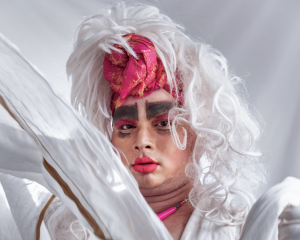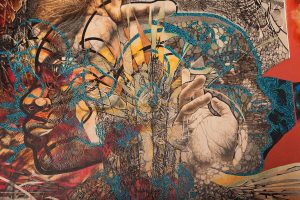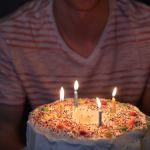For partners of transgender people who come out
By: Anne M Reid
Smug. That is how I felt in my marriage. I was almost 36 when Paul and I met randomly at a bar in Brisbane. I figured that I must have applied the right amount of patience and discernment, because the alchemy of my relationship with Paul had resulted in a near perfect mix of respect, love, passion, forgiveness. Plus, he was the best lover I’d ever had.
After moving to America, Paul, who had been working from home for years, started to become depressed with the isolation and solitude. He couldn’t connect with the locals, which was a feeling I had too, except I didn’t realise at the time how this disconnect would manifest itself.
It wasn’t until we’d been together for some 12 years that Paul revealed to me, late in bed one night, the fundamental underpinnings for his feelings of disconnect—he had gender dysphoria.

A partner coming out as trans demands understanding. Photo: Media Coopers. Licensed under Creative Commons 2.0.
I had no idea what this even meant. Paul began unleashing a whole plethora of bottled up feelings, emotions, thoughts, desires, facts, happenings, and details that I had no idea were lurking beneath his skin. He had wanted, as a child, to be a girl, and had been hugely disappointed when the coming of puberty did not change his body into the feminine form he had envisaged. He buried the inherent thoughts and desires deep down within the subconscious and covered them with layers of masculine pursuits to forget and annihilate.
The revelations were so out of the blue. Once Paul had his epiphany, he was hell-bent on making some drastic changes as quickly as possible. I barely had a chance to type ‘gender dysphoria’ into Google before I found out that Paul was intent on changing his name, gender presentation, body, and pronouns.
Paul had started taking hormones and anti-adrenals to balance mood and emotions and it was left to me to ascertain that these were the first steps towards a full transition. Paul was now to be known as Paula. Surgery was scheduled for as soon as possible.
Numerous blank faced selfies began to populate our photo stream. Changed body odour permeated our bedroom. Our bathroom cabinet began to bulge with potions and lotions, hair-removal devices, waxes and creams, hair styling implements, palettes of eyeshadows and blushes, makeup brushes, a selection of shampoos and conditioners. Someone I had always considered to be so self-effacing and stable, was now obsessed with the dramas of broken nails, and determining what to wear.
My world shattered into a thousand shards. I felt hurt, betrayed and blindsided. We had spent so many wonderful years together, in a loving and respectful partnership, but it was now clear that Paula had been keeping a deeply concealed secret from me this whole time. Our former life together was being obliterated before my eyes. Our family memories came to seem false as we now had to erase a central character who we felt we knew deeply.
My smugness was now replaced with a sense of gullibility. How on earth had I seen no signs? Had Caitlin Jenner’s transition been some sort of trigger? I had no idea how to gather all the shards of my life together again, let alone begin to glue them back to make it whole again. The shards had been altered, and the life I thought I had been living, would never fit together the same way again. I had a lot to learn, a lot to process and a lot to even begin to understand.
I launched myself into the mission of trying to understand what was happening. In a slow slide into my own depression and darkness, I read everything I could digest, watched TED talks and YouTube videos, joined a private Facebook group of people who were wearing the same shoes as I now found were lodged firmly on my feet.
After the renaming and the she/her pronouns, Paula became more comfortable at home, seeking solace within the family rather than externally on chat sites and Slack forums, where she messaged other transgender people. She seemed more focused on the well-being of the family and, more specifically, on my well-being. I finally felt I was seen and considered, and heard.
I was not at all gracious/benevolent in the early stages of Paula’s transition. It took some time to comprehend it all, let alone accept that the deep disconnect Paula had been feeling her whole life had compelled her to make such drastic changes to affirm her gender.
Our three children were my greatest teachers—with a pure innocence not tainted by societal influence, their simple and straightforward acceptance of our new normal helped break through my resistance to the situation.
I now find myself living a strange new life. If someone has a problem with my wife, our relationship, or our family, it is their problem, not ours—and we’re better off not having those people in our lives anyway.
Successful relationships are a combination of chance, respect, commitment, good luck, and good humour. I have a partner who is loving, a great parent, cares for and respects me, supports me financially and emotionally, makes me laugh and accepts my foibles. The qualities that attracted me to Paul, remain within Paula. I didn’t foresee it at the beginning, but a combination of time, patience, reflection, empathy and personal growth really does make it easier.
Anne M Reid explores her partner’s revelation, transition and the impact this has on her and her family’s life in her memoir She Said She Said: Love, Loss & Living My New Normal. Released in April with launches to occur in Brisbane, Sydney and Melbourne, the book is available on Amazon, Booktopia, Book Depository, Kobo, iTunes or book stores. Anne’s website has resources to assist with understanding a partner’s transition, and details about the book launch.













